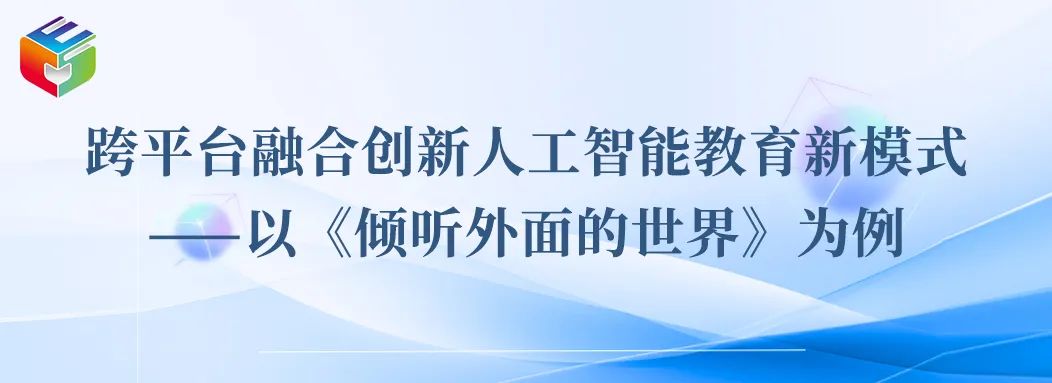
Jiang Li, Pang Kunyong, Sun Jian, Li Xiao
Huangdao Primary School, Qingdao West Coast New Area
Qingdao West Coast New Area Education and Sports Research Institute
Abstract Since the popularization of AI education, major companies have launched AI courses entirely based on their own hardware and platforms, making it difficult for AI education to take root in primary and secondary schools. The cross-platform integrated AI education model is based on the smart education environment provided by various districts and cities, allowing students to explore the sources of AI projects from real-life situations, guiding them to combine reality with their learning to unleash their imagination and creativity to complete works belonging to their teams.
Keywords Artificial Intelligence; STEAM Education; Project-Based Learning
Artificial intelligence involves knowledge of big data, voice recognition, machine learning, image recognition, and other technological fields. How to introduce these concepts to elementary school students, how to allow them to experience AI in a step-by-step manner, and what course models to use for AI education are all pressing issues that need to be addressed. In an era of knowledge explosion, traditional educational models cannot equip elementary school students to thrive in the future AI era.
Currently, many AI education platforms exist, which are in a “divided” phase. “What is divided will eventually unite, and what is united will eventually divide.” AI education must differ from other subjects, including programming education. The project-based STEAM+AI cross-platform model of education enables students to learn through self-directed inquiry, supporting the construction of a tiered ecological system for AI education in primary and secondary schools.
1. Introduction to the Cross-Platform AI Education Model
(1) Theoretical Basis
Artificial intelligence is an emerging technology that simulates human intelligence through perception, reasoning, and behavior. AI not only impacts people’s lives and drives social development but also promotes the advancement of human thinking. AI education encompasses knowledge from various fields, including computer science, mathematics, philosophy, physiology, and psychology, making it a highly interdisciplinary new subject. The underlying algorithms of technologies such as machine learning, voice recognition, and image recognition in AI education are quite complex, involving advanced mathematics and numerous high-tech theoretical concepts. At the onset of AI education’s popularization, when teachers introduced AI education to students, they often thought of robots and products that seemed far removed from their daily lives and learning, which detracted from the essence of AI education. AI education should not place AI on a pedestal that students cannot reach but should allow them to find the sources of AI projects in their lives. Therefore, the project-based learning approach, which emphasizes learning through play, is very suitable for AI education and aligns with the STEAM interdisciplinary education philosophy.
If AI education is taught using traditional methods, dividing knowledge into chapters and units for students to understand concepts like voice recognition and machine learning will not only increase the academic burden on teachers and students but also risk having the scientific knowledge students use today become obsolete in the future AI era. AI education must be conducted in a manner that differs from traditional education and even from programming education. The new project-based learning approach to AI education enables students to learn through self-directed inquiry, develop teamwork skills, communication skills, and innovation capabilities, thereby enhancing their intelligence literacy.
In summary, guided by theory and practice, AI education in primary and secondary schools employs a new cross-platform integrated innovative AI education model based on interdisciplinary educational concepts. It begins with projects derived from students’ life and learning contexts, allowing teachers and students to experience AI-related knowledge using various platforms within the smart education environment. The entire experience can take place not only in classrooms but also in STEAM studios, AI family maker spaces, and surrounding social environments. The series of AI education courses will decompose a large project into sub-projects, continuously iterating and evolving the projects.
The cross-platform integrated innovative AI education model employs an important “expand-shrink-expand” approach to cultivate students’ innovation capabilities. At the beginning of a project, students first find the source of the project from their lives, which is the “expand” phase. When teachers explain foundational knowledge, they use a specific tool or platform to solve a project, which is the “shrink” phase. Finally, when students create projects, they combine real-life situations with the knowledge they have learned to create unique works for their teams, choosing other AI platforms for creation and applying for hardware to extend vertical and horizontal projects, enhancing their self-directed inquiry learning abilities, communication skills, and teamwork capabilities, which is the “expand” phase. The numerous works produced by students can be used for display, communication, promotion, and competitions, allowing parents to personally experience the entire creative process of their children. The project education under the cross-platform integrated innovative AI education model ensures that every student has an AI product.
(2) Model Significance
Cross-platform refers to both the cross-platform teaching by teachers and the cross-platform learning by students.
Student learning: AI has rapidly developed since 2000 with deep learning, and the most well-known model is CHATGPT. However, this is just one model. Major companies like Baidu, Tencent, and Google are researching their own AI education platforms, providing their models on these platforms, which are entirely based on the companies’ own platforms and hardware, and often charge fees. This is a divided phase. “What is divided will eventually unite, and what is united will eventually divide.” This book uses a cross-platform approach, allowing course content to be experienced without platform limitations and guiding students to free methods of experience.
Teacher teaching: Utilizing the smart education environment, including public service platforms, Qingdao E platform, and centralizing AI education resources in teacher spaces, students can access these resources for self-directed inquiry learning. Parents can also view their children’s growth online, extending from this popular course to enrichment and advanced courses.
In summary, the significance of the cross-platform model is that teachers, before, during, and after class, identify project needs based on students’ life and learning contexts, using various online learning platforms emerging from the smart education environment to guide students and parents to participate in AI education projects, establishing family maker laboratories and promoting the exhibition of students’ AI products both online and offline. The smart education environment includes platforms such as Qingdao E platform, central AI course systems, Tencent AI education modules, Puyou education platform, SenseTime platform, public service platforms, school communication, and various teaching assistants.
(3) Model Stages
The cross-platform model is generally divided into four stages, as shown in Figure 1.
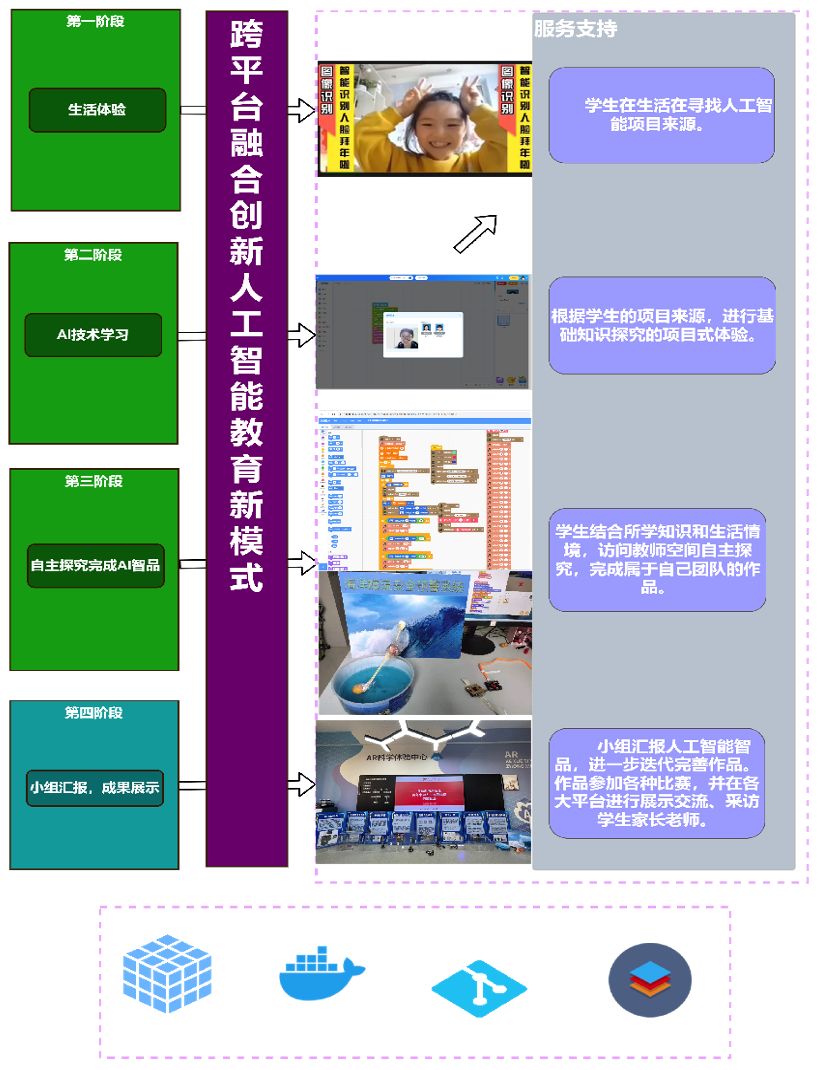
Figure 1 Cross-Platform Model Stages
The first stage is life experience, where only part of the educational process is completed in school, and many aspects require students to derive AI creative sources from life and ultimately apply them in real life.
The second stage is AI technology learning, where project-based learning is conducted based on students’ life experiences.
The third stage involves students conducting self-directed inquiry and collaborative learning based on their foundational technical knowledge.
The fourth stage is where groups report on the results of their AI products and further iterate and improve their works.
2. Introduction to the Cross-Platform Implementation Environment
(1) Hardware Introduction
The curriculum system for AI education is divided into popularization, enrichment, and advanced education. To better allow students to experience AI, the hardware setup can be as simple as a computer with a camera and headphones, or a group can have a control board. The use of the control board is not only to experience AI but also to enhance students’ interest in learning and to experience mathematical knowledge. The interdisciplinary educational philosophy used in this textbook involves mathematical knowledge, including coordinate systems, making it easier for students to understand coordinate concepts with physical objects.
When conducting project-based teaching, it is important to note that hardware should be used to better achieve our project teaching goals and not overly relied upon. In this textbook, control boards, micro:bit, Arduino, and iFLYTEK’s Xiao Fei can all be utilized. Ultimately, each student’s work is based on different foundational knowledge.
Throughout the project teaching process, we only use open-source hardware control boards to assist STEAM+AI project teaching, increasing students’ experiential interest while downplaying the functionality of the hardware. This textbook emphasizes the cultivation of original innovative abilities, including those of teachers.
(2) Platform Environment
The control board can be connected and operated on the Qingdao E platform, which also has a virtual control board for experimentation. In addition to the E platform, MIND+’s Baidu service and Puyou’s openinnolab platform can also be connected. The difference is that the Qingdao E platform calls Tencent Cloud AI interfaces, while MIND+ provides Baidu Cloud AI interfaces. MIND+’s Baidu Cloud interface has service usage limits, while the Qingdao E platform has VIP restrictions on Tencent AI services. This textbook adopts a cross-platform teaching approach using the Qingdao E platform linked to Tencent and the MIND+ platform using Baidu services, as well as the Puyou openinnolab platform and iFLYTEK platform for implementing AI courses.
Some existing hardware, platforms, and resources may be phased out in a few years, but the advent of AI will not be limited by certain hardware or VIP platforms. AI will inevitably transition from a weak era to a strong era. To ensure that students are not limited by hardware and platforms, this textbook’s programming implementations or AI experience platforms are not restricted. Students can utilize the current MIND+ for experiences, as well as the Qingdao E platform we are using. While we cannot guarantee that the resources students experience will not be phased out as they grow older, at this stage, students have utilized these platform resources to experience AI projects and have learned to engage in self-directed inquiry learning. Even in new learning environments in the future, students who have experienced the projects in this textbook will still be able to learn, experience, and create in conjunction with their lives.
The first half of the textbook’s projects allow students to experience technologies such as voice recognition, image recognition, and the Internet of Things. After students create intelligent products that make life more convenient and beautiful using these technologies, they may come to appreciate the power of AI technology. Therefore, in subsequent projects, this textbook is designed to guide students to experience some of the supporting algorithms behind AI. Born in 1956, AI has experienced multiple peaks and valleys over its more than sixty years of development due to factors such as intelligent algorithms, computational speed, and storage levels. In recent years, with the rise of big data and improvements in computational power, especially the emergence of new machine learning algorithms, AI has entered an era of explosive growth. Big data + algorithms + computing power is AI, or large models. Knowledge related to AI should form a tiered curriculum: elementary school experiences, middle school understanding, and high school writing.
What will elementary school students gain from their experiences? Through teachers’ guidance, students will develop a desire to further understand the underlying data and algorithms, leading to a tiered AI education where middle and high school students learn corresponding algorithms. Therefore, teachers need to familiarize themselves with supervised, unsupervised, semi-supervised, and reinforcement learning in machine learning, as well as understand the KNN algorithm and decision tree algorithm categories, allowing students to ultimately grasp the differences between machine learning methods and human learning methods. Elementary school students should no longer view AI through a black box, thinking of it as an unreachable robot, but should be encouraged to actively explore, develop a love for research, and become the next generation of AI leaders.
3. Case Study: ‘Listening to the World Outside’
Project Example
The ‘Listening to the World Outside’ project allows students to choose a sound from their lives, such as their father’s voice, the sound of the sea, or the clanging sounds from a construction site. Students quietly listen to this sound for ten minutes and record their thoughts and feelings in a STEM practice report. Then, teachers use various platforms and tools online to explain the foundational knowledge of the control board, teaching students how to convert invisible light and sound into visible shapes displayed on the control board. Next, students experiment with converting the sounds they hear, during which teachers guide them to explore knowledge with a questioning spirit, embodying the idea that “to trust books too much is worse than not reading at all.” Through layered guidance, students’ self-directed inquiry abilities are enhanced. From their father’s voice, students hear paternal love; from the sound of the sea, they hear tolerance; from the construction site, they learn the importance of study, and so on, enhancing their values and perspectives. Based on this foundation, students extend their vertical and horizontal projects, creatively using the control board to apply the project to their lives and studies.
The implementation environment of the ‘Listening to the World Outside’ project is open, inclusive, and innovative across platforms. Its project framework is shown in Figure 2, consisting of four sub-projects: Sub-project 1 involves students exploring sounds from life; Sub-project 2 investigates the stories behind listening; Sub-project 3 explores the stories behind light; and Sub-project 4 examines the stories behind the outside world.
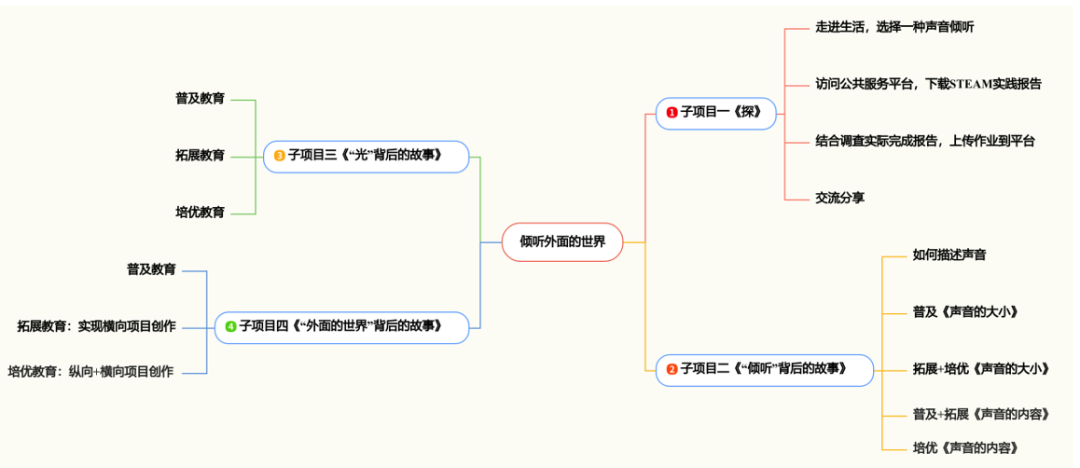
Figure 2 Project Framework
The ‘Listening to the World Outside’ project breaks down the boundaries between life and learning, starting from real-life situations to explore the sources of AI projects, which is the “expand” model. Next, teachers guide students to use the principles of analog-to-digital conversion to implement intelligent light control and sound control systems in the classroom, as well as to understand the hardware setup of light and sound control systems through sensors, expansion boards, and control boards, which is the “shrink” model. Through layered guidance, students’ self-directed inquiry abilities are enhanced. Based on this foundation, students extend their vertical and horizontal projects, creatively using the control board to apply the project to their lives and studies, combining their investigations of life with the information technology knowledge they have learned to unleash their imagination and creativity, completing intelligent systems unique to their groups. This is the “expand” model. Using the “expand-shrink-expand” model maximizes the retention of students’ imagination and innovation capabilities while guiding them to experience foundational knowledge in the classroom. After experiencing this, students can maximize their imagination and innovation in project design and creation.
(1) First Stage: Exploration
Students choose a sound from their lives, such as their father’s voice, the sound of the sea, or the clanging sounds from a construction site. They quietly listen to this sound for ten minutes and record their thoughts and feelings in the STEAM practice report, including improvements in their values and perspectives, practical applications of scientific principles, and enhancements in parent-child relationships, all documented in the STEAM report, as shown in Figure 3.
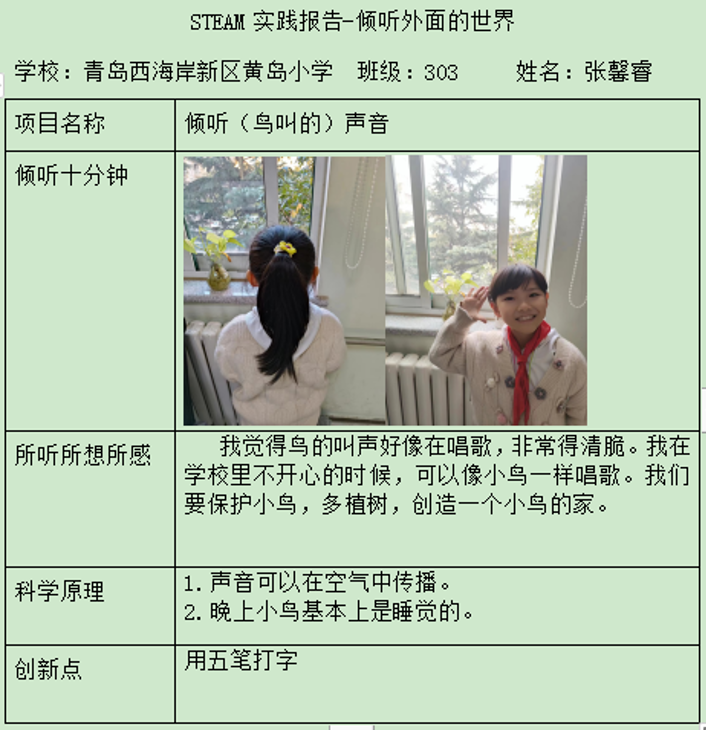
Figure 3 ‘Exploration’ STEAM Practice Report
(2) Second Stage: Students Explore Voice and Image Recognition Technologies Based on Their Chosen Projects
The theoretical learning of foundational knowledge in AI technology primarily involves mathematical concepts such as coordinate knowledge, analog-to-digital conversion knowledge, and OLED screen line width drawing, as shown in Figure 4. Cross-platform education encourages both parents and students to actively participate in this activity, achieving home-school co-education, and under the influence of interest, students’ self-discipline gradually strengthens.
The stories behind listening relate to sound, describing the volume and content of sounds. The volume is represented through analog-to-digital conversion, turning the sounds heard into bar graphs, which involves mathematical knowledge and artistic experience. The content of the sounds relates to voice recognition, creating control systems. The stories behind light involve the presence of light during listening, using the intensity of light to create control systems. The stories behind the outside world relate to image recognition knowledge points.
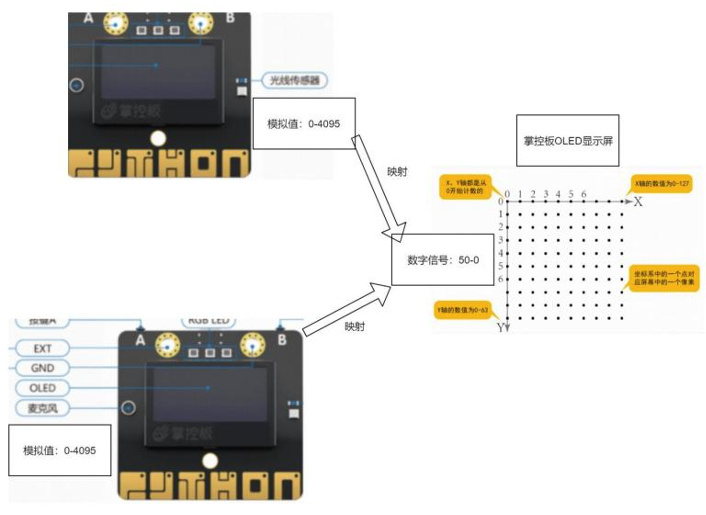
Figure 4 OLED Principle
(3) Third Stage: Exploring Applications of Voice and Image Recognition Technologies through Vertical and Horizontal Project Creation
After accumulating foundational knowledge in mathematics and technology, students venture out to listen to the world and create vertical and horizontal projects. From students’ STEAM practice reports, it is evident that during their exploration of the world, they have enhanced their values and perspectives, as well as their understanding of scientific principles, ultimately converting the sounds they hear into visual representations. Subsequently, they continue their self-directed inquiry into the applications of sound in intelligent systems, which constitutes a series of vertical projects. Based on the videos recorded and images captured during their exploration of the world, they engage in intelligent creation, forming a series of horizontal projects.
With a foundational knowledge base and intelligent literacy, the later project-based learning is entirely driven by students’ self-directed inquiry. Teachers organize relevant resources needed for learning into public service platforms, allowing students to explore projects based on their interests under teacher guidance.
Whether horizontal or vertical projects, teachers no longer need to teach specific programming knowledge step by step. Students engage in self-directed inquiry and creation, completing AI products. Teachers concentrate the resources available for students’ self-directed inquiry in teacher spaces, as shown in Figure 5.

Figure 5 Teacher Space
Students have created intelligent supermarkets, license plate recognition systems, access control systems, smart lamps, intelligent safes, smart trash cans, sound-controlled lamps, light-controlled lamps, and quoting robots. Many projects have multiple methods for problem-solving and achieving results, allowing me to cultivate students’ emotional intelligence: in learning and life, they will encounter many problems and should think of several solutions, choosing the most suitable and effective method to solve problems. Along with the education of intelligent knowledge, emotional intelligence, and values, students’ intelligent literacy has significantly improved.
(4) Fourth Stage: Displaying, Promoting, and Competing with Students’ AI Products
AI education is not a subject where results are directly visible through exams; rather, it reflects students’ overall qualities, such as improvements in other cultural subject scores, logical reasoning skills in problem-solving, and students transferring their love for watching cartoons to self-directed inquiry learning in online spaces. Therefore, ‘Listening to the World Outside’ places great emphasis on process evaluation, observing feedback from students, parents, and society through the number of likes and comments on the platform.
The outputs of this project, including students’ works and parent interviews, are showcased and evaluated at the International AI Alliance, provincial resource platforms, and provincial maker competitions, as shown in Figures 6 and 7, receiving numerous awards and honors. More importantly, both teachers’ and students’ innovative capabilities and overall qualities have improved.
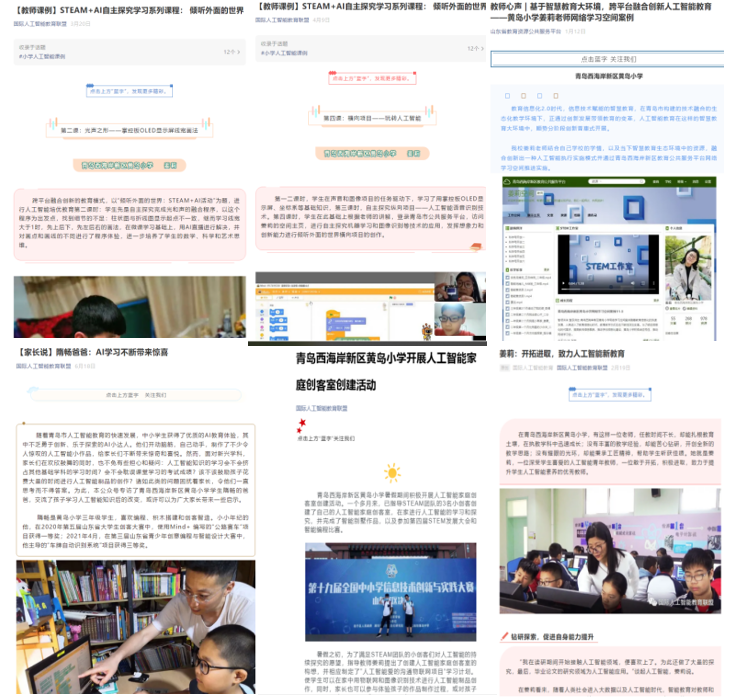
Figure 6 Competition Promotion

Figure 7 AI Roadshow Scene
Conclusion
The cross-platform integrated innovative AI education model has been implemented again in STEAM+AI, confirming that interest is the key to unlocking students’ self-directed inquiry learning, while project-based learning gives wings to AI education. The sources of projects stem from life and ultimately serve life.
AI education is a new discipline, and the focus at the elementary school level should be on cultivating AI literacy rather than merely imparting AI knowledge. Today’s elementary school students are the future leaders in the era of strong AI. Their intelligent literacy must be nurtured from a young age, fostering a love for technology, a passion for research, and problem-solving skills. The time for AI education is now; it is not programming education or robot education. Under the guidance of a new model, it highlights the characteristics of AI education and cultivates seeds of artificial intelligence.
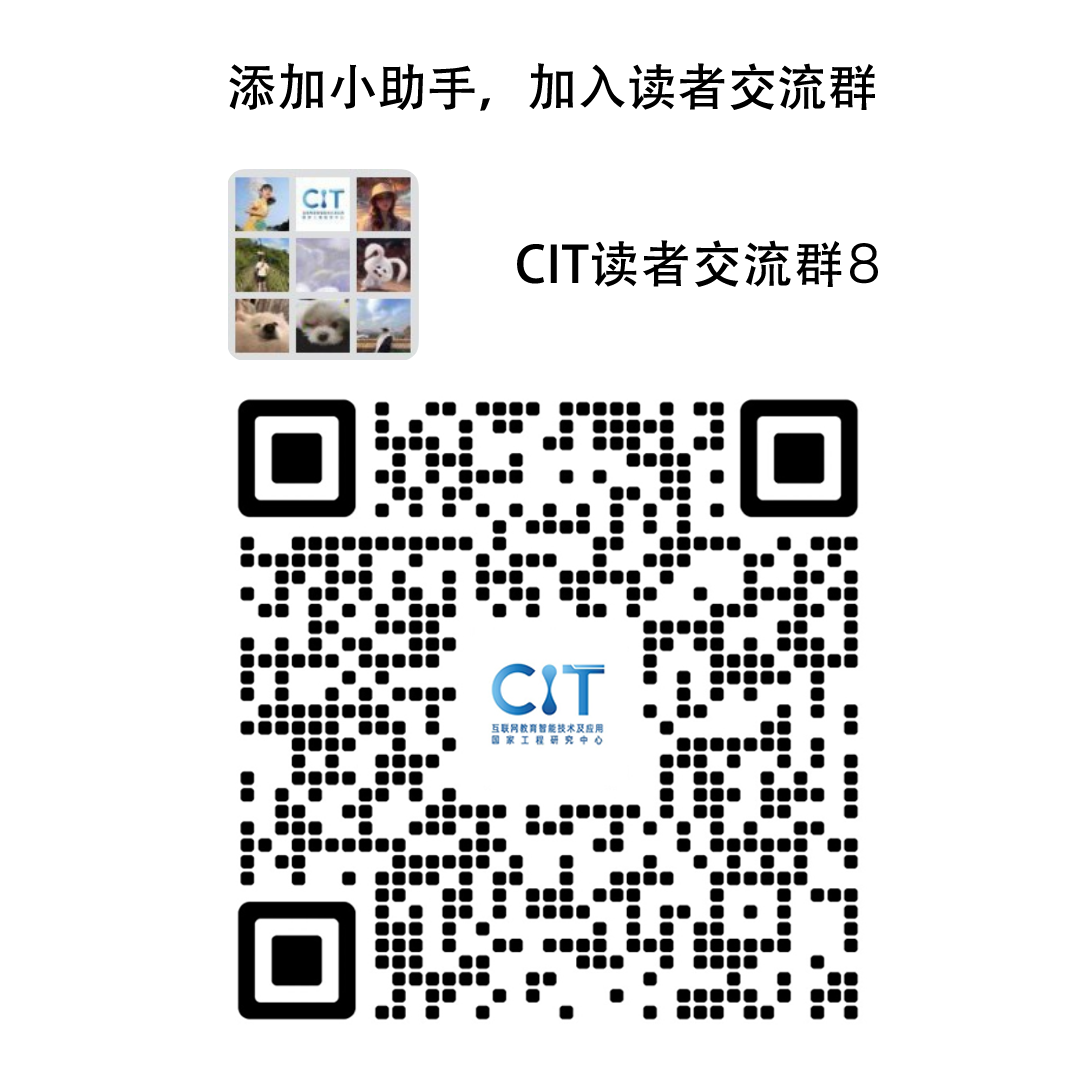
Previous Reviews
1. Observations from the 2024 Global Smart Education Conference
2. Summary Report of the 2024 Global Smart Education Conference
3. Notification of the Announcement of the 2024 Excellent Cases of Smart Education
4. Announcement of the First Global Smart Education Innovation Award Winners
